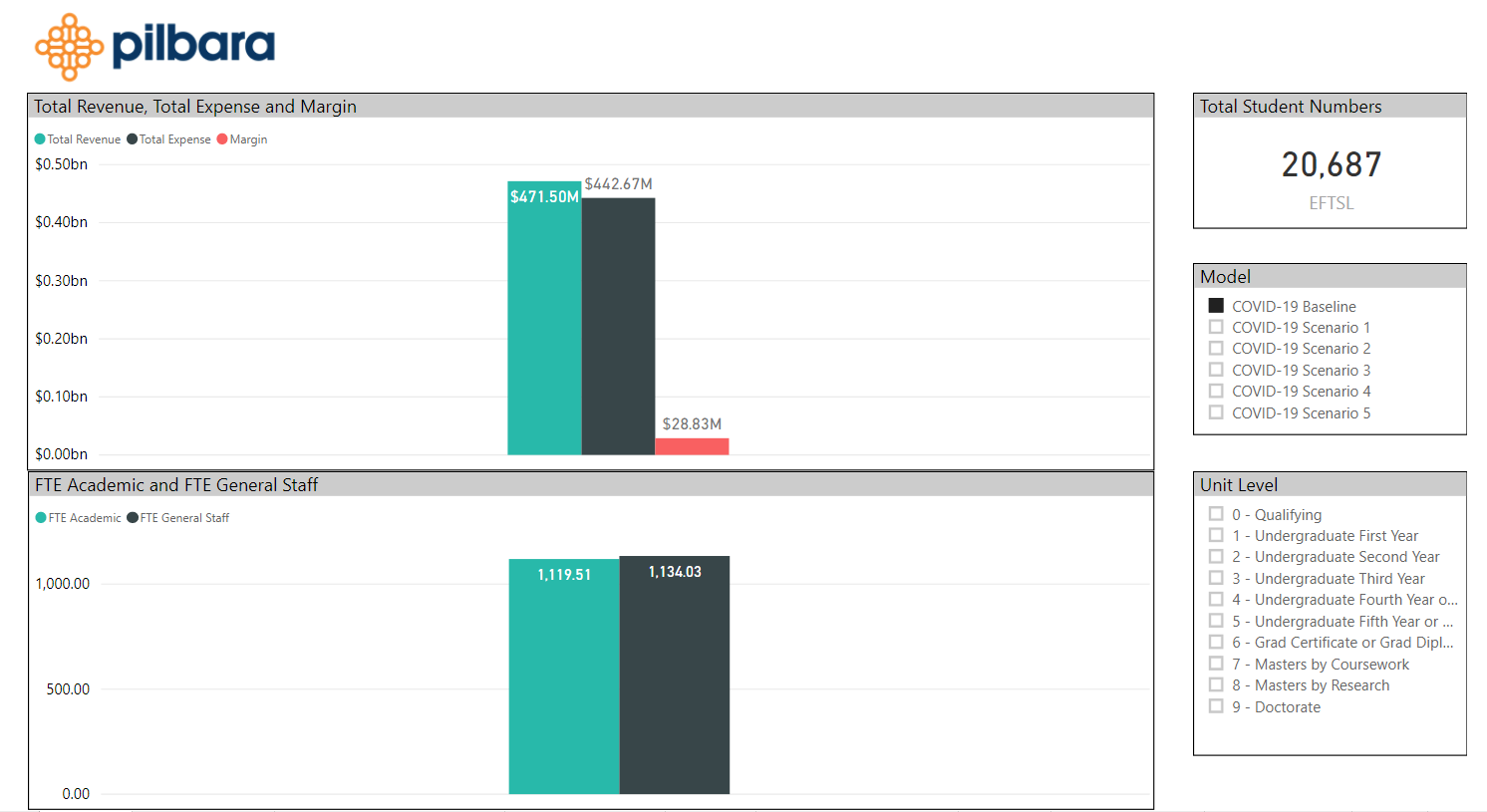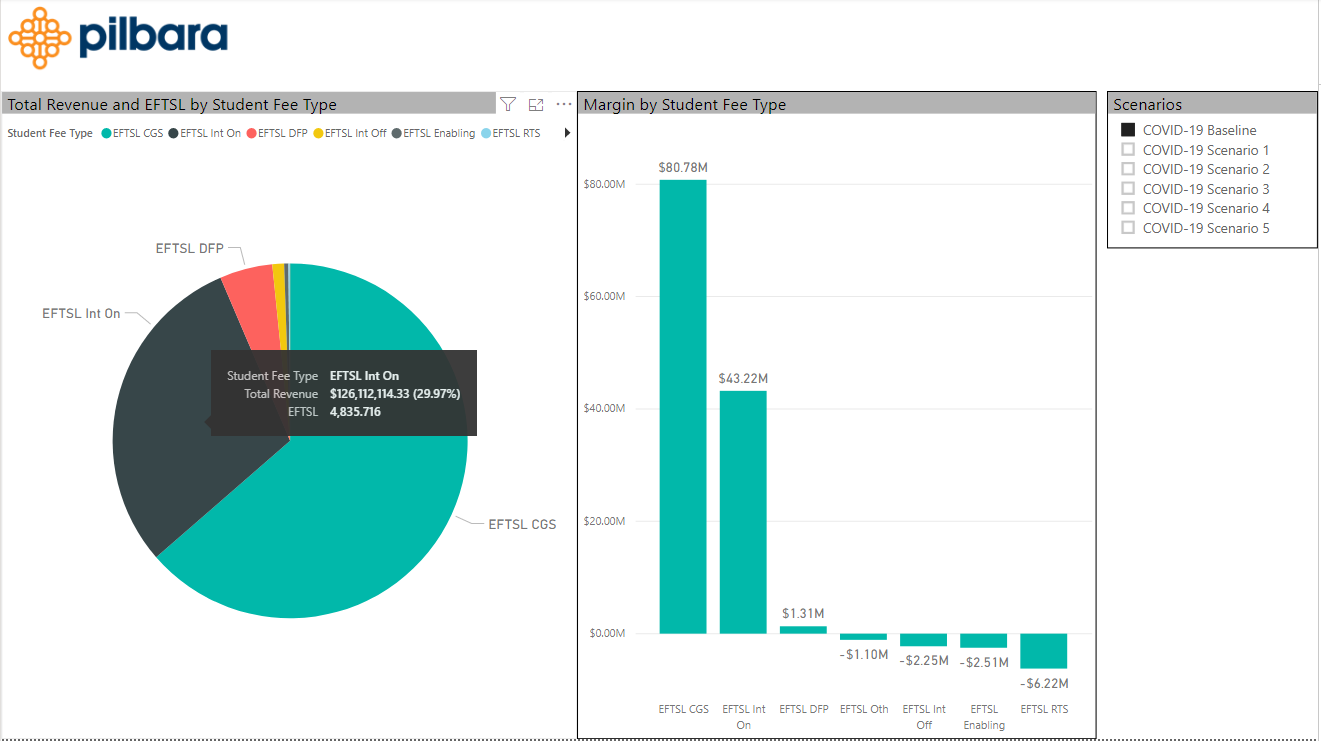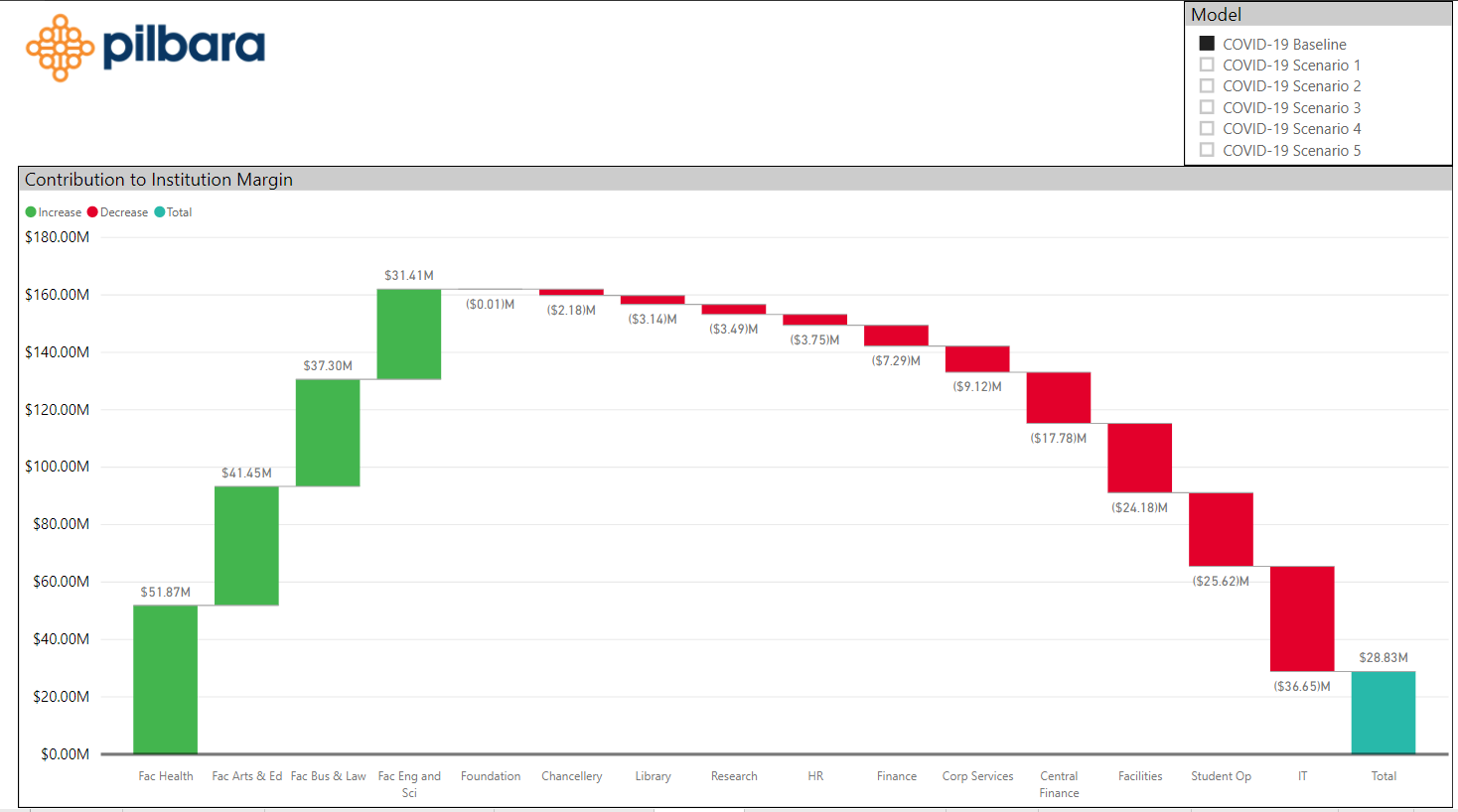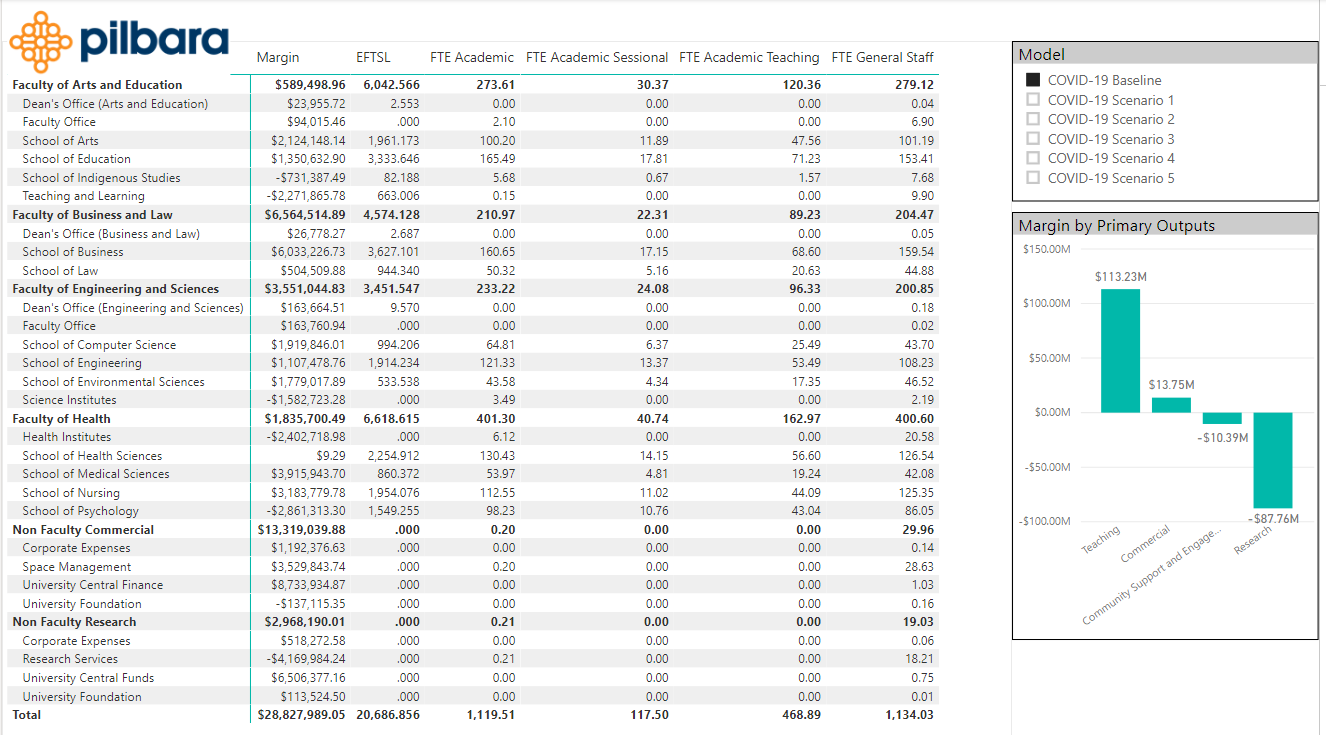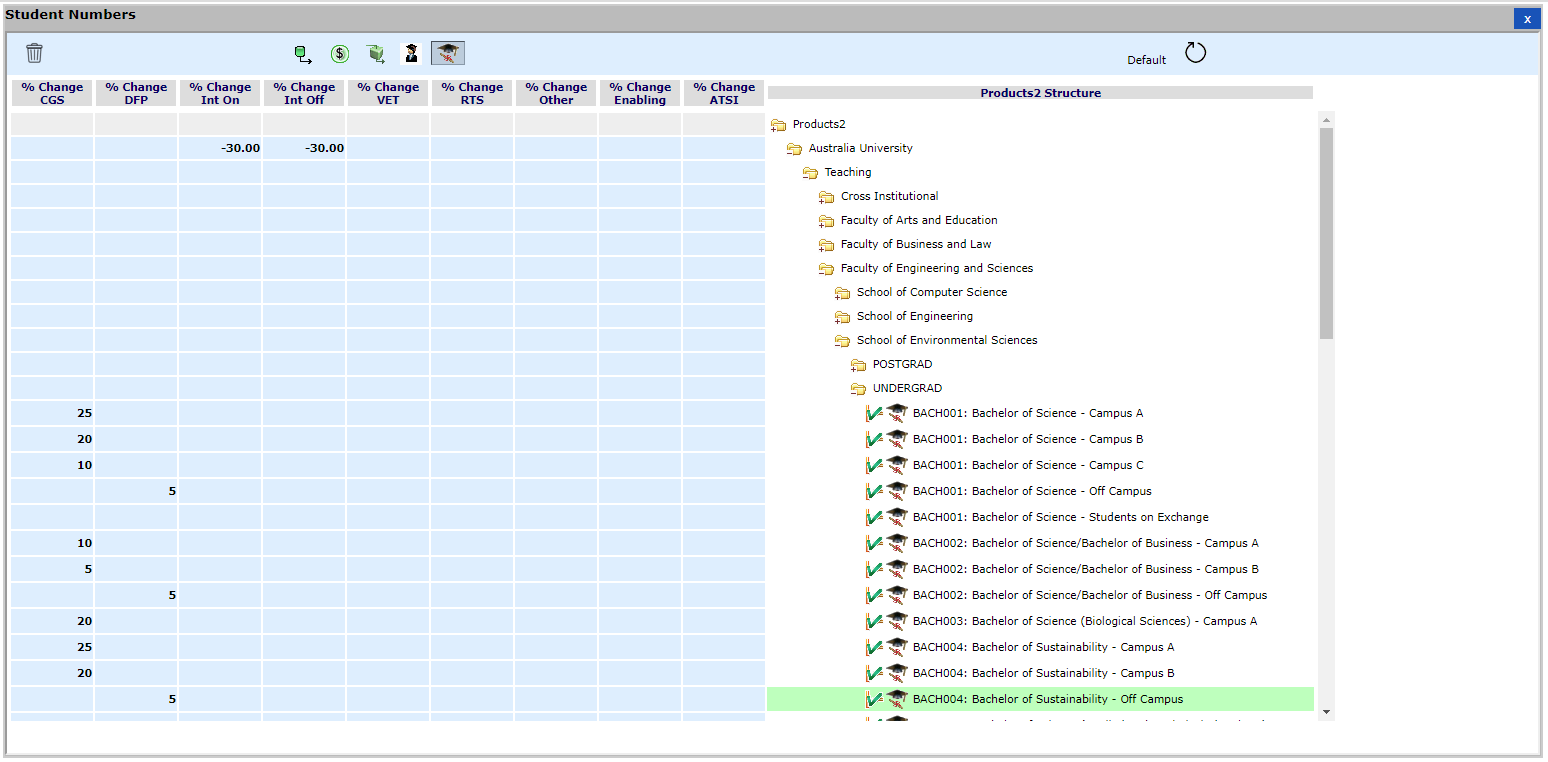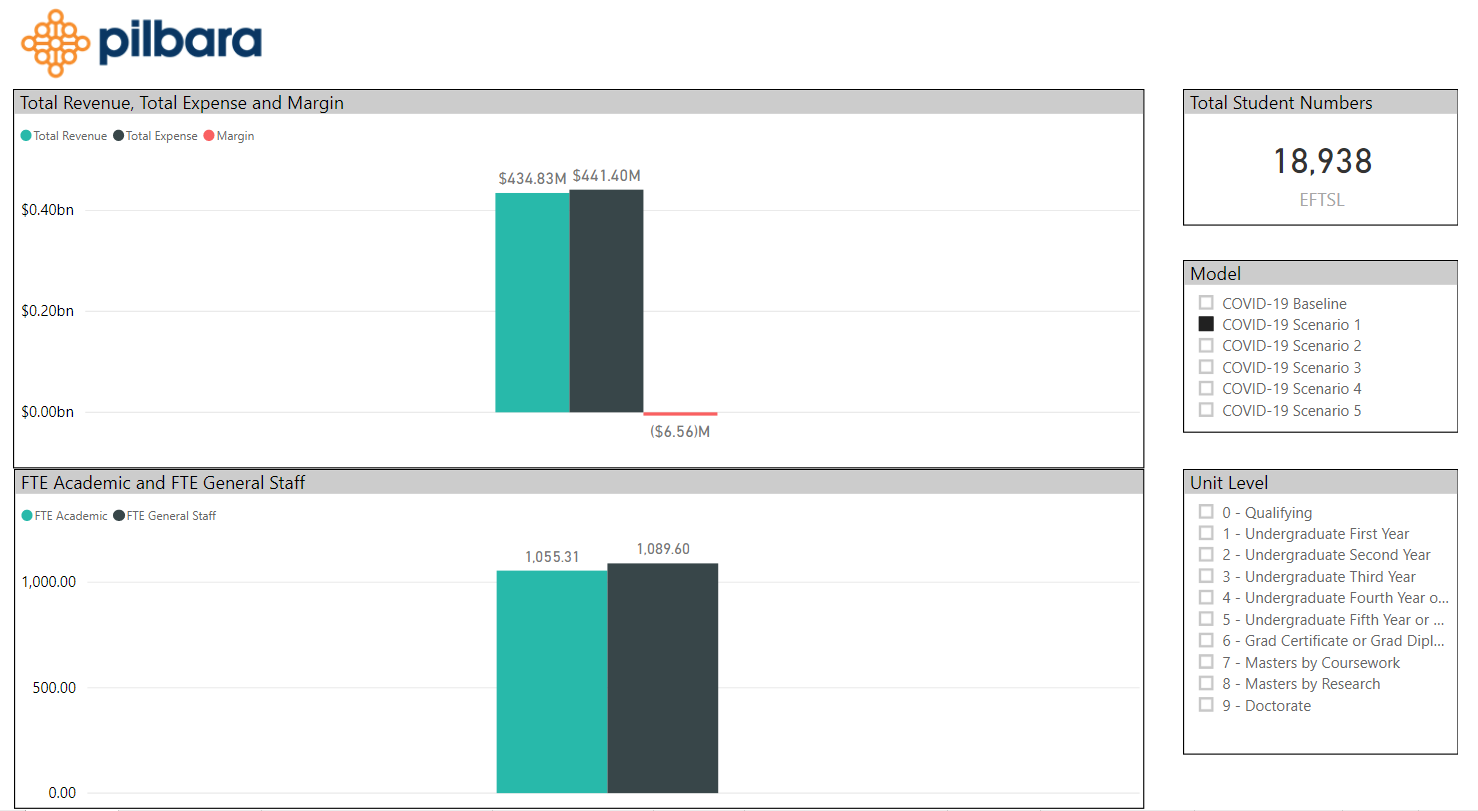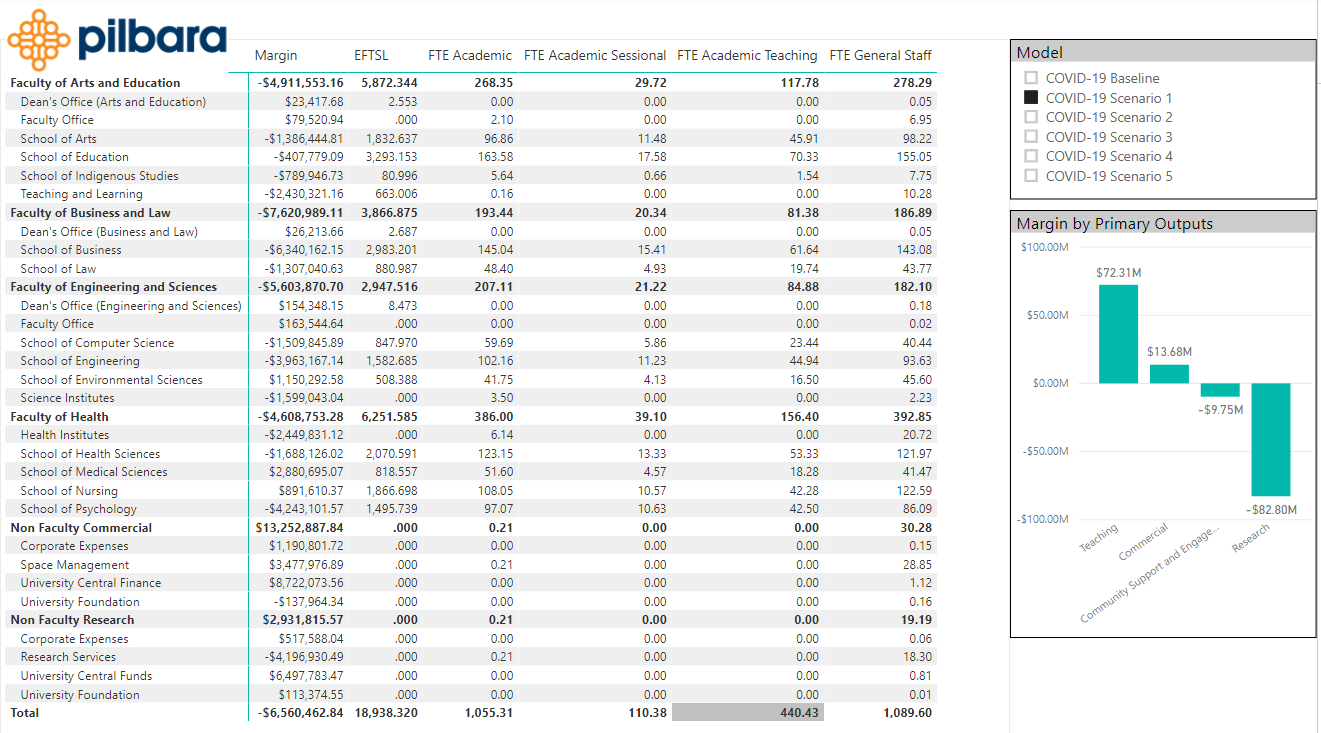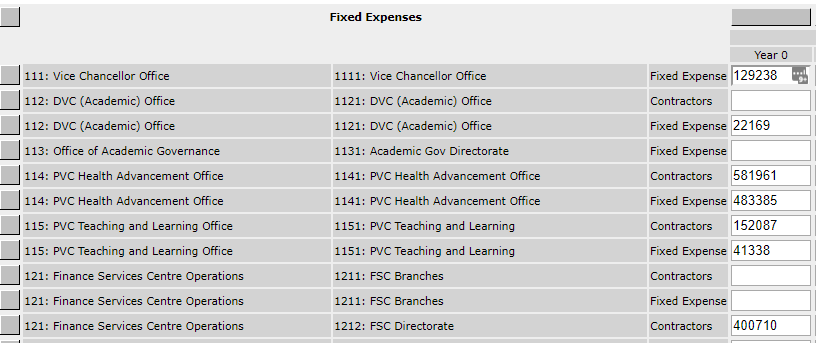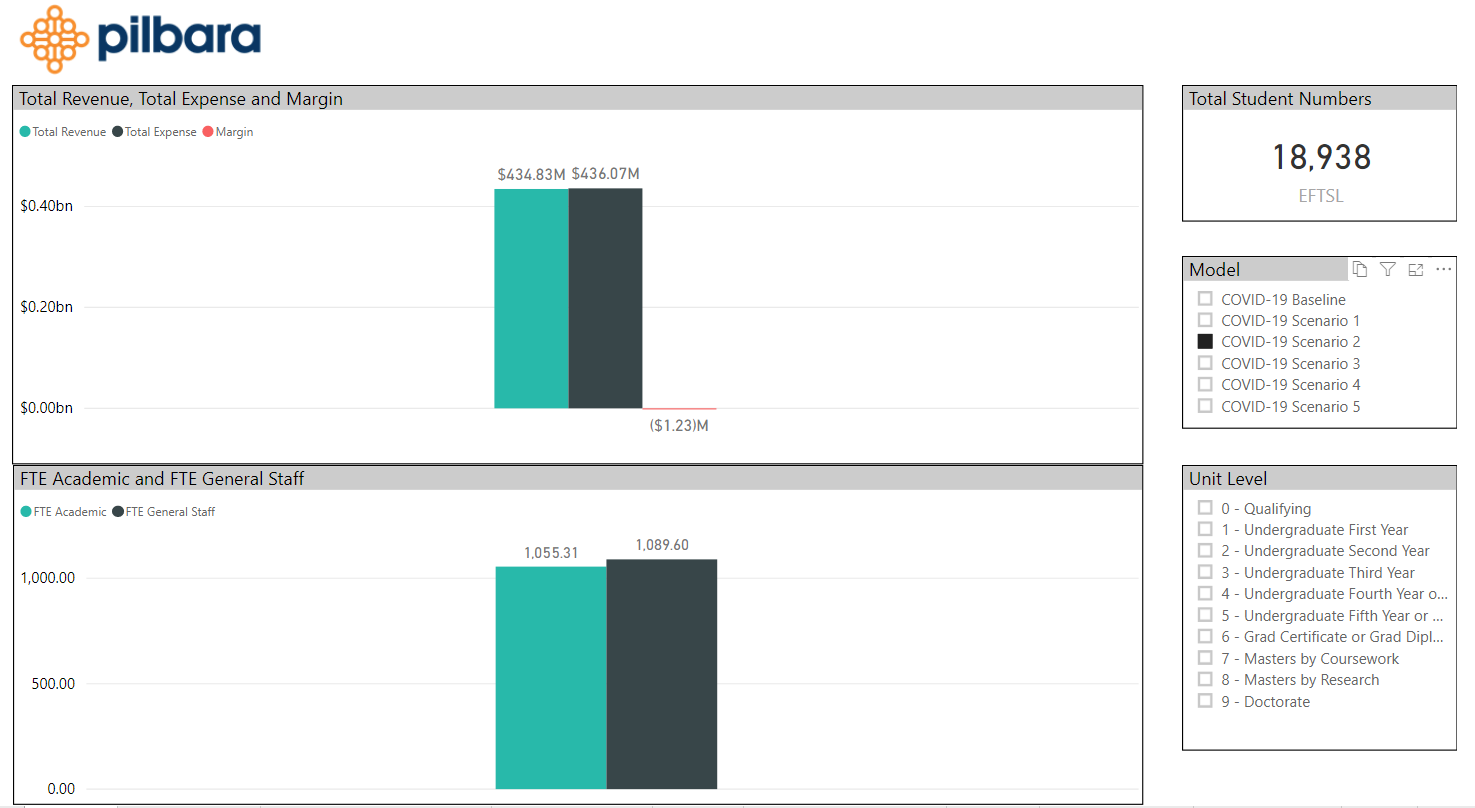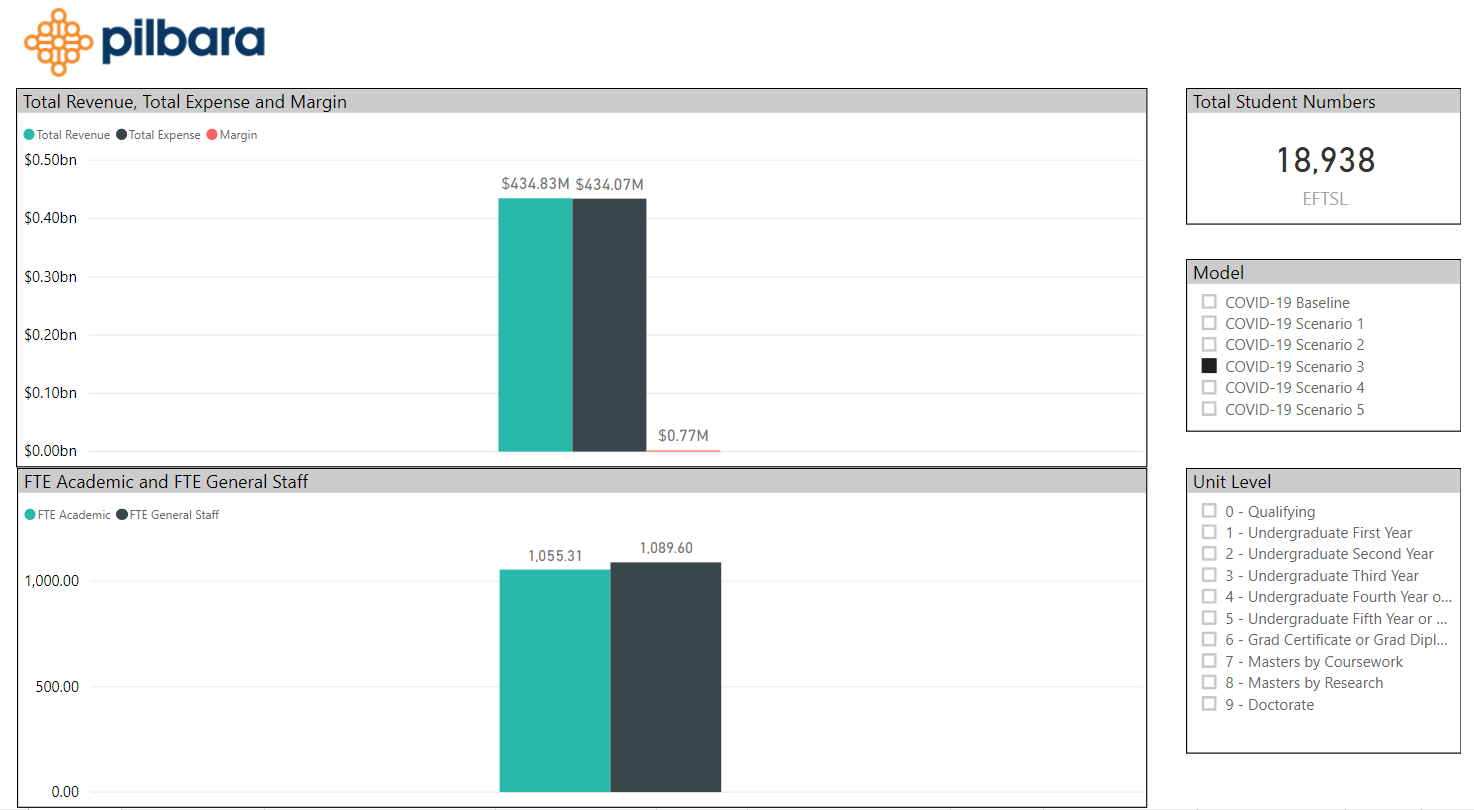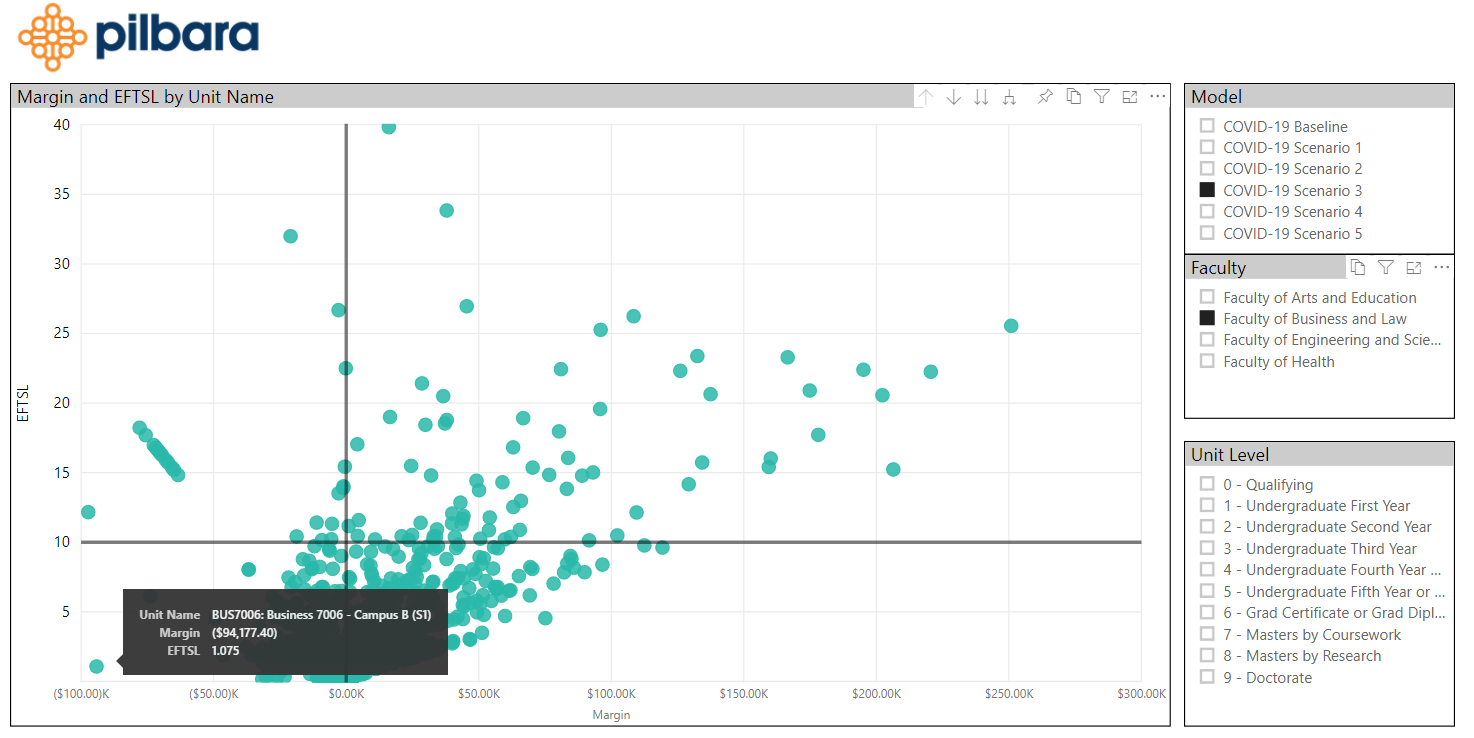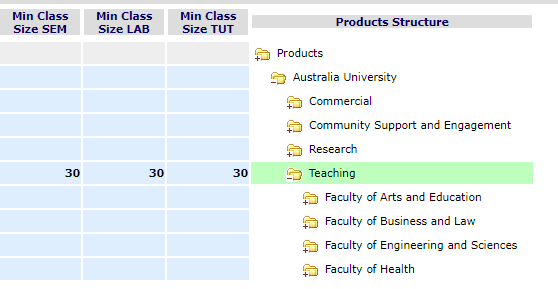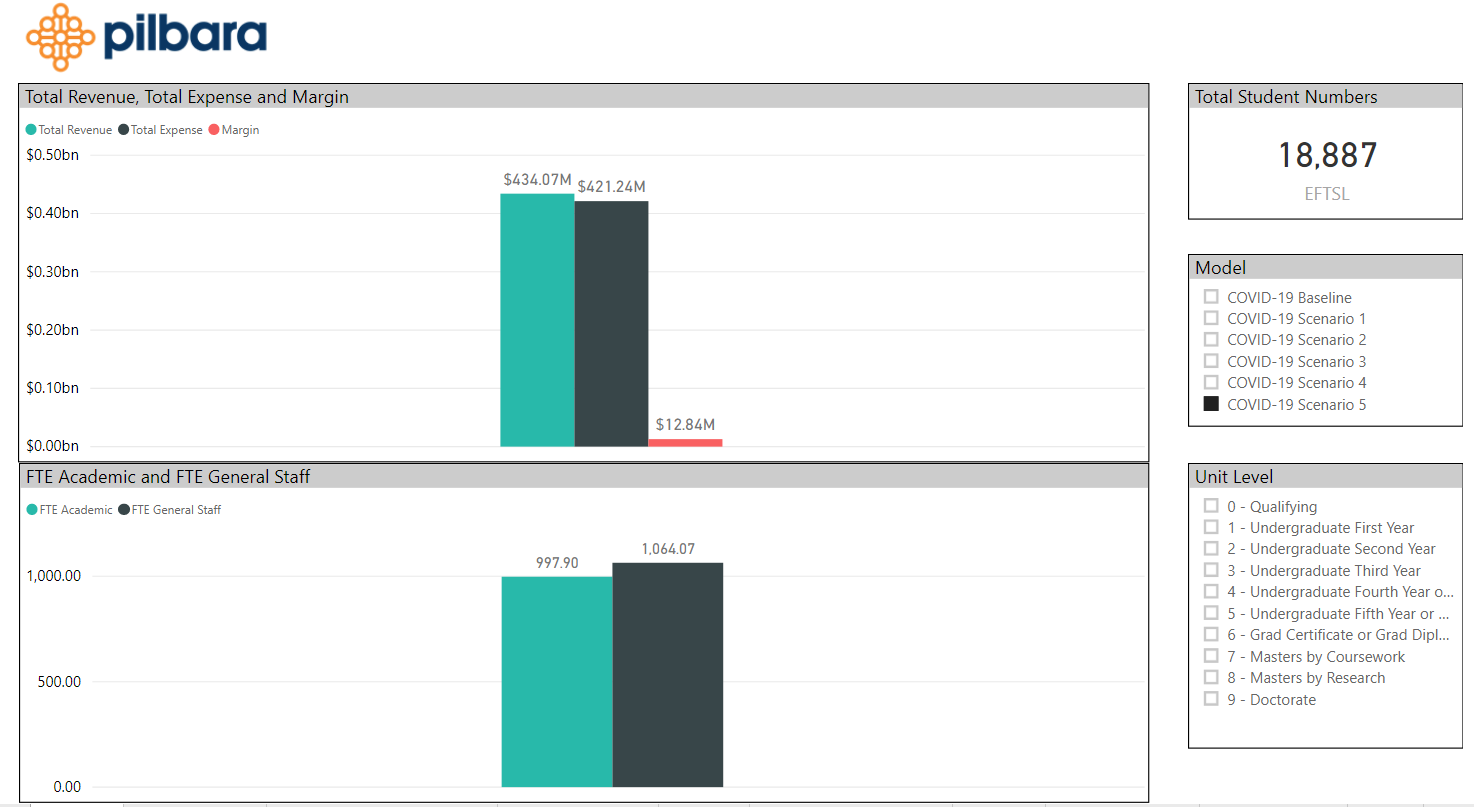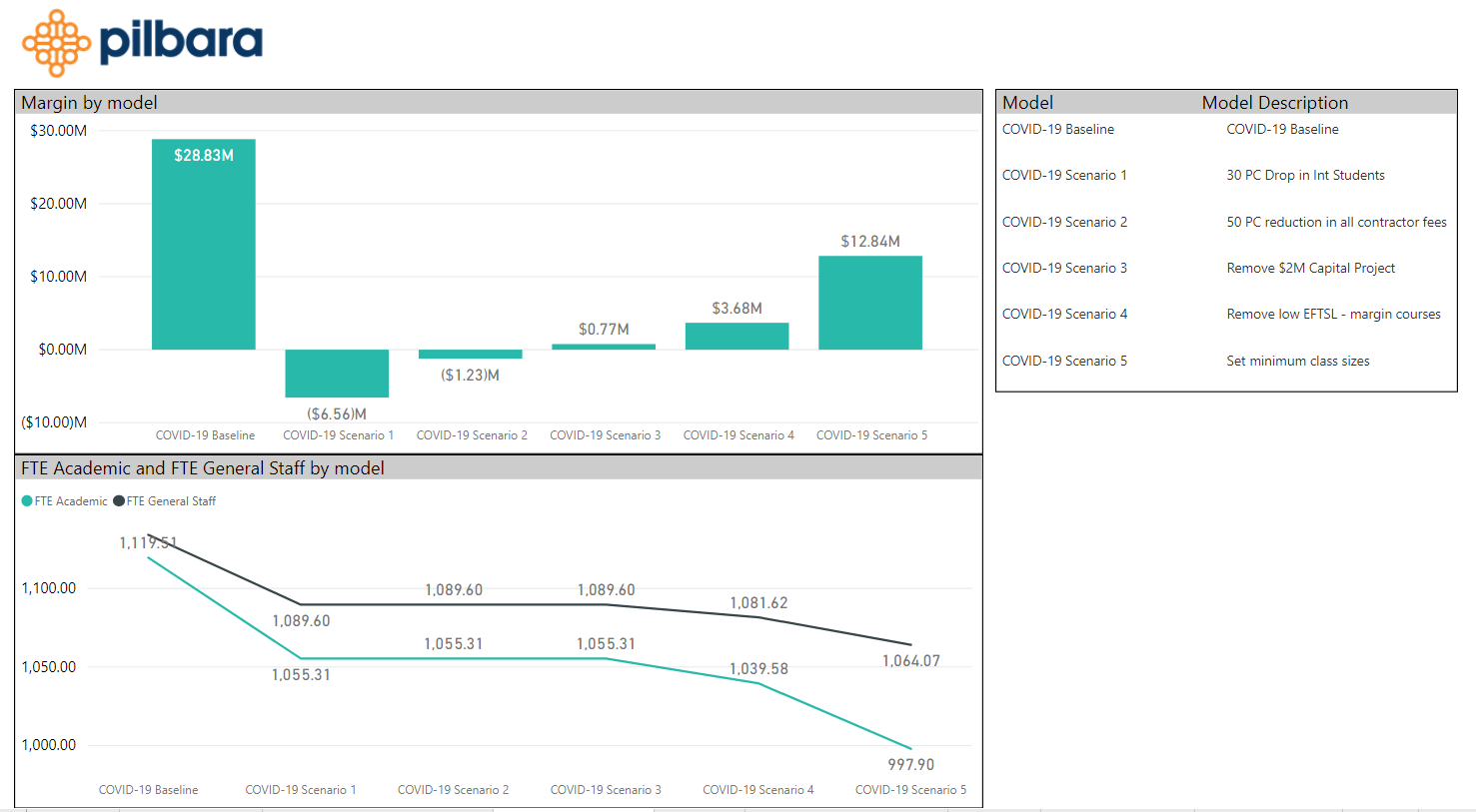Using the Pilbara predictive model to test crisis management options for university leadership.
By Michelle Brooke, Lea Patterson, Andrew Faulkner and Professor Alan Pettigrew BSc (Hons) PhD FAICD
Introduction
Although they are no longer run, the LH Martin Institute (University of Melbourne) used to offer courses for aspiring University Vice-Chancellors (VCs) covering a range of leadership and management topics.
Pilbara participated in these courses in one particular area – crisis management. Back then, the course participants would spend a day analysing the current financial situation of a fictitious university, with the aim to increase the university’s margin over a 5-year period alongside nominated changes to its mission as outlined by the institution’s governing body (here we will call it the Council).
After spending the day (hopefully successfully!) running scenarios using Pilbara’s predictive model to allow them to respond to the Council, these aspiring VCs would retire for the night, content that their institution was happily in the ‘black’ over the next 5 – 10 years. However, when they turned up for class the next day, they were presented with the details of a ‘crisis’ – a sudden 20% drop in international student numbers. They then spent the next two days in crisis management mode, modelling dozens of scenarios on varying approaches to, if not return to the ‘black’, then at least minimise the ‘red’.
Today, universities across the globe are living this crisis in reality due to the Covid-19 pandemic sweeping the world. The types of analyses that Pilbara took those aspiring VCs through are outlined below and apply equally today – in fact, they should be at the forefront of every university CFO’s mind today, with his or her VC right there too.
The first part of this report presents an overview of typical impacts and responses to them of the crisis currently facing universities across the world. This overview raises the importance of data and analysis of the emerging situation and the prospect of scenario modelling to help universities address their circumstances and to plan, as best anyone can, for the future. The second part of this report presents sample data from a fictitious university (based on a selection of real cases) along with the series of questions that can be asked and some scenario modelling, or big ‘what-if’ type questions, to assist decision making.
In a time of crisis, it is important to understand the shape of the institution from a student, staffing and financial perspective so that it can be managed appropriately, rather than making large cuts based on high level broad analyses, or guesswork.
Background
As we have seen from recent press reports, universities have reported significant budget shortfalls in 2020 arising, primarily, from lower enrolments of international students. In response, 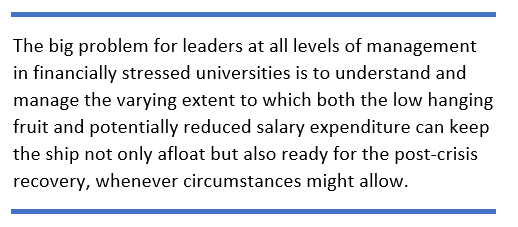 immediate actions were to trim the low hanging fruit – cutting expenditure on capital projects, travel, consultants and many other forms of discretionary and strategic spending, and imposing a hiring freeze. These cuts will help boost whatever reserves a university holds that can be expended on costs not met by the crisis-driven reduction in income. But it’s also often the case that reserves can vary in size and accessibility in the short-term to support liquidity. Moreover, the biggest expense at a university is payroll so this has to figure in the mix of strategies that universities look at when needing to meet significantly reduced income.
immediate actions were to trim the low hanging fruit – cutting expenditure on capital projects, travel, consultants and many other forms of discretionary and strategic spending, and imposing a hiring freeze. These cuts will help boost whatever reserves a university holds that can be expended on costs not met by the crisis-driven reduction in income. But it’s also often the case that reserves can vary in size and accessibility in the short-term to support liquidity. Moreover, the biggest expense at a university is payroll so this has to figure in the mix of strategies that universities look at when needing to meet significantly reduced income.
The big problem for leaders at all levels of management in financially stressed universities is to understand and manage the varying extent to which both the low hanging fruit and potentially reduced salary expenditure can keep the ship not only afloat but also ready for the post-crisis recovery, whenever circumstances might allow. For example, if large cuts are made to staff numbers, without fully understanding how their cost contributes positively to the past and future income and financial position of the institution, then the university could be doing more harm than good. This applies to both the academic staff and the professional staff of the institution. There are also different issues arising when considering the financial impact of reducing staff numbers with different contractual and employment arrangements. The objective in a crisis should be to minimize the number of staff cuts because when things eventually start to pick up, the institution will (or is very likely to) need those people again1 as it’s more expensive and time-consuming to recruit new people than it is to maintain existing staff. On the other hand, leaders must also decide which of the lost strategic projects might need to be re-resourced in order to sustain or indeed advance the institution in the longer term. None of this is easy, but it is essential that decision making going into the depths of the crisis as well as emerging from it must be based on sound analysis of available data2.
One of the very first things institutions should do is analyse the sources of their income and identify the types of threats to that income that are emerging. Across the higher education sector, these threats may vary from time to time and be relatively slow moving. Think, for example, of changes in government funding that are introduced with phasing over several years so that sudden impacts are avoided. In contrast, the current circumstances are quite different, there being a sudden decline in student numbers, increased costs associated with a change in delivery methods and pedagogy, and rescue packages required for students in immediate financial distress3. Here, for the moment, we will defer consideration of short-term measures that governments might apply in an attempt to sustain their higher education sectors. Such new measures have to be seen against the base condition in which the institution finds itself in the current crisis. Without that understanding, a VC cannot effectively understand, assess or utilise the help that may be on offer, nor can they fully appreciate the impact of the strings that may be attached to the offer of help.
It is not easy nor generally required to construct complex financial models or strategies for the management of low hanging fruit. In general terms, these usually include centrally supported, discretionary, large, capital infrastructure (buildings, IT systems, research equipment and other infrastructure), consultants who have been hired to help deliver strategic initiatives, centrally sourced funds to support research and teaching activities (both general and specific), support for staff travel and myriad other relatively low-cost activities. The tool to deal with these matters is simply to turn off the tap. The result is a known saving against the budget. But such savings may be insufficient to balance the real loss of income. Of course, it is tempting to draw down on investments, but care is required here when those long-term investments normally provide an income stream. Attacking the problem this way is simply a “double -whammy”. A common further step therefore is to start to address the matter of salary expenses by imposing a ‘freeze’ on promotions, hiring (or at least imposing a requirement for high-level approval to fill essential positions), bonus payments and the like. Do these strategies relieve the financial pressure? Indications in the current crisis are that the pressure is very much more significant and likely to last for several years hence.
Where to start and what to do?
Rather than waving one’s hands over a crystal ball, a VC must now tackle more complex strategies for cost reductions through engagement with the breadth of the institution and its operations. In order to do this effectively it is first essential to have a good understanding of the major source of the current problem – student related income. What parts of the income base are affected and to what level, and is the effect evenly spread across source areas and the academic units of the university? These data should be readily available from existing enrolment systems and should prompt some early thinking on how to address the issues arising.
Teaching:
Next, it is important to understand all the factors associated with the delivery of the education that enrolled students expect to receive in accordance with their contract with the university. These factors include staff related costs and the availability and use of infrastructure and fixed assets. Many if not all of these factors are required to maintain external accreditation of professional courses. This means that there will be some stringent limits on the available strategies that might be required to realise savings in some faculties as opposed to others.
Once these factors in individual faculties are understood it is necessary to be able to follow the linkages between unit offerings and degree structures within and between faculties and schools and the related income-sharing between organizational units within and between faculties. Perhaps more significantly and on a broader scale, it is normal these days for there to be significant cross-subsidies between relatively high income (volume-related) / low cost faculties (e.g. business) to high (but inadequate) income / high cost faculties (e.g. medicine and veterinary science). Again, these cross-subsidies will limit the strategies that can be applied across the institution and it is certain that a general one-size-fits-all approach to budget savings across faculties will not be possible. Decisions will have to be strategic and based on all the relevant data.
Research:
Universities pride themselves on their research outcomes and the reputation (and international rankings) so generated has a lot to do with attracting excellent students, staff and investments from industry and the philanthropic sector. Higher education is now a global competition for talent. However, research is only partially funded through short-term, ‘project-based’ grants and institutional block grants from government to support infrastructure and related costs. Thus, some more established universities apply philanthropic and or investment income to support their research portfolio. In the main, however, there is a long history of universities cross-subsidising the costs of research from the income generated through teaching, especially these days from international tuition fees. In a crisis, where student related income is reduced, then research will also be impacted. Some research may continue, assuming that current external project grant funding will continue through the immediate crisis period, and, hopefully, beyond. But will that and other internally funded research be impacted by reductions in available funds from student fee income? What choices need to be made to sustain research – either as a whole or in part? Moreover, research is a long-term activity, both in terms of expertise and careers, as well as meeting the highest standards of method and rigor. It would be of significant concern, for example, if strategies to address a financial crisis meant that higher degree students near the end of their candidature were required to suspend or, at worst, terminate their research activities that have been years in the making and nearing completion.
It is also the case that strategies to address the impact of a financial crisis on research cannot be disentangled from the strategies to address the impact on teaching. Put simply, this is because current employment arrangements include the general expectation that most academic staff will also undertake research. Thus, the dimensions of the data required for sound decision making that will have a long term impact must include evidence of excellence in both teaching and research4.
Professional staff:
The education and research functions of a university, as well as its business operations as a not-for-profit legislated entity, are dependent on a wide range of professional staff. The range of specialist capacities and capabilities required is significant and of a scale that is often not well understood. There are professional staff required at faculty and school level, where operations can be quite specific for the type of teaching and research undertaken in those organizational units. There are also university-wide specialty service areas supporting teaching, research, student administration, finances, human resources, information technology, community relations, legal affairs, governance, and facilities and infrastructure. Most of these largely administrative support areas are usually under constant surveillance for efficiency and effectiveness, and systems improvement, so that resources can be directed away from administration to the institution’s focus on teaching and research. When it comes to assessing functionality in a financial crisis it is probably fair to say that optimizing activity with available resources is more of an art than a data driven science. Nevertheless, these decisions need to be based on a thorough understanding of work priorities and the balance of skills and staff numbers required to sustain the university’s operations. Again, data are required, largely drawn from the HR and finance systems.
To sum up, any university is a complex, difficult beast to manage at the best of times. In the worst of times it is a very challenging task indeed. But challenges must be met, and tools are available to assist in meeting those challenges. The tools depend on data and well tried and tested routines for data extraction, analysis and presentation. The advanced step in the use of data is to construct scenario modelling where any number of variables can be manipulated to show up deficiencies or advantages in strategies that might be considered for implementation, as well as the consequences.
Where to from here?
Assuming a university has the data available, predictive modelling offers an opportunity for enhanced management and governance before, during and after a crisis. Perhaps the current crisis will encourage further exploration of the potential for sophisticated data analysis and modelling amongst higher education institutions. Certainly, there has been a call for a more united front across the global higher education community for sharing of data and operational analyses so that trends and approaches to management in times of crisis or relative stability can be shared for the advantage of education and research globally5.
As stated in the introduction to this paper, the current crisis has prompted universities to adopt a number of important variables into their operations as they race to sustain their functions, student cohort, research activity and staff. It is likely that these strategic variables will be reviewed many times over the weeks and months ahead whilst keeping an eye on various day by day indicators, hoping all the time that the variations in activity and strategy will lead to positive and intended outcomes. Scenario modelling can also provide an indication of those outcomes, perhaps ahead of the real short- or longer-term impact, so that strategies can be modified accordingly.
A widespread response to the current crisis has been the almost overnight transition from face-to-face to on-line teaching. This has been a considerable short-term adjustment in many areas of a university’s operations for staff in faculties, schools, teaching support areas, IT, and communications. What will be the impact? What will happen if student attrition increases, or the opposite? What is the impact on academic and support staff, systems and potentially on the reputation of the university? Scenario modelling has the potential to give an indication of the consequences before, as well as while, new data emerge.
Finally, like all other sectors, universities individually and collectively will be seeking government support to sustain their operations through the crisis and beyond. The sudden nature of the crisis has and may continue to evoke a sudden change in policy and funding from government. Just how each individual university can respond to a sector-wide change in direction is probably largely unknown at this time. For example, we have seen the Australian government largely abandon the international student cohort in preference to offering a change to domestic student arrangements by supporting short courses and micro-credentials in areas of high demand for expertise, notably nursing, for example. Accommodating the potential long-term loss of international student enrolments whilst attempting to boost skills upgrading of the domestic cohort in some specialized areas in the immediate months ahead lays out a complex challenge for any institution.
Has there been any serious scenario modelling at government level to assess the impact of these strategies? All we have, apparently, is an estimate of potential billion-dollar losses to the sector and a requirement that each university look after itself, as best it can. It remains to be seen just how ‘best’ that can be.
The following pages provide an insight into what is possible using institutional data and scenario modelling through the Pilbara predictive model.
PART 2: Pilbara data mining and predictive modelling
In the following pages we will discuss the application of several crisis scenarios based on the Covid-19 experience to date compared to the “situation normal” model of a fictitious university. The construct of the ‘Australia University’ (AU) is based on a methodology developed over twelve years for about 20 different universities and is representative of how the real model operates under similar circumstances. The main benefit of the predictive model is that one can adjust inputs to the model, such as student load and fee income and/or an increase in expenses and the model will automatically calculate the indicative impact on staff distributions and costs. It is a relatively fast analysis that can be re-run at will, as circumstances change. It is also possible to include in the model the cost saving of managing the low hanging fruit described earlier. The predictive model will be used here as a tool to explore options university leaders can take and what the expected outcomes could be.
It’s important to note that the Predictive Model doesn’t provide any one answer. The future hasn’t been written yet and there are many possible futures. The Predictive Model allows the senior executive group to further consider the financial impact of a range of potential decisions that may (or may not) be on the table at their specific institution. For each one of these decisions there would be numerous other non-financial considerations as to whether they are viable or not (mission) in addition to the financial decision (margin).
It’s also important to note that one of the unique strengths of the predictive model is the concept of the course profile. These are 20-30 data points that describe the course instance (when, where and how it’s taught) including class sizes, teaching hours, preparation hours, administrative hours, number of students and types of students etc. Because of the current crisis, institutions have had to significantly change the way they teach, by bringing a lot of courses online as well as creating a series of shorter courses. Because of the course profile concept, if the institution can manually populate these new profiles then the predictive model can be used to forecast the new teaching workload required to support an increased online teaching load and new short courses.
As mentioned previously, personnel are the biggest expense at a university, so a number of the scenarios will involve an impact on staffing in order to balance cost reductions with expected revenue reductions.
So from the university point of view, the model will provide indications of:
- How many FTE do we need to reduce to meet budget?
- If we do that, what is the impact on our teaching and research capability?
- In which schools are the impacts greatest?
- How much teaching might be re-gained from a change in internally funded research time?
- What impact would re-arrangement of curriculum delivery make to the sustainability of some academic programs (e.g. reduce courses offered, increase class sizes, change timetables, etc.)?
- What savings can we make in service delivery / corporate services?
The Scenario
COVID-19 has had a major impact on Australia and internationally both from a public health and economic perspective. For the fictitious “Australia University” (AU) it has been estimated that the international student numbers have fallen by 30%. There could also be a further hit with international students pushing back on the fees charged if they have to study online (this could be the same for domestic students as well). Furthermore, because all non-essential workers have been told to stay at home during the crisis, this means all students have to study remotely. Unfortunately, AU only had a few courses available online so there has been a major ramp up of activity developing online curriculum which has been estimated to cost the university an additional $120 per EFTSL. To ensure international students remain with AU the executive have decided to provide financial support to all the international students with a package set at $2070 per International EFTSL (or per student if desired). What impact has all of this had on the financial performance of the institution and what actions could be taken to mitigate the situation?
The Analysis
So for you, the VC of AU, you will need to focus on the following three key areas:
- What is the impact on the university’s overall margin, and where is the impact on student-related income most acute? What are the implications for all parts of the university?
- What are you going to do immediately? For the current COVID-19 crisis that means what happens for the rest of 2020, based only on events in semester 1.
- What are you going to do next year? No one knows what will happen next year, the best we can do is to develop a number of different scenarios covering worst-case and best-case situations and then compare them and prepare appropriately.
To set the scene, the following is the baseline financial position of AU – it has a 2020 budget margin of $28.83 million which is approximately 5% of the total university normal annual revenue of $471.5 million, of which about 30% is derived from international students.
The contribution of each faculty (by university output) towards the $28.8 million margin is shown below:
Another way of looking at it provides a clearer understanding of which areas of the university’s key operations contribute to an increase or a decrease in the final UA margin. This is illustrated below.
Finally, bringing in the schools and EFTSL/FTE metrics, we get a more detailed view of the same result:
The astute reader will notice that the margins are different per faculty between these last two charts. Think of them as the “before” and “after” picture in the model. The “Contribution to Institution Margin” figures in the graph show all the revenue, expenses and margins before the model is calculated. The table above is after the model is calculated and all of the service areas (HR, Finance, Corp Services etc) have been “consumed” by the faculties to provide the “fully absorbed” margins in the “after” picture. But you will notice that the overall university margin is exactly the same $28.83 million in both.
This baseline information is fundamental to understanding normal operations and it is essential for knowing where the shortfall in international enrolments is likely to be having its greatest impact. In the scenarios that follow, we first form a picture of what the decrease in enrolments and other related increased costs would have on the staff numbers in AU. We then look at the mitigation of this impact by reducing overhead or administrative expenses (some low hanging fruit) before embarking on reductions in staff expenses, especially from schools and faculties where the income line is so important.
Scenario 1
The first scenario is a decrease in international student enrolments by 30%. For simplicity, this scenario is assuming a uniform 30% drop across all faculties for the whole year. In the next article this will be broken out by semester with assumptions on variations per semester to provide a more detailed analysis.
Furthermore, we can accommodate variations in specific numbers for individual faculties, schools or even individual degrees / programs in the model. These variations can be entered at the appropriate faculty and/or school level within the institution’s hierarchy and will be explored in a future article.
A variable expense can also be set to cover the additional cost of transition to online teaching, estimated here at $120 per EFTSL, applied uniformly across all programs (although this can be varied according to the proportion of current on-line versus other forms of teaching). If relevant, this can easily be set as a fixed expense.
 It is also possible to apply a variable expense to cover financial support to international students, estimated here at $2070 per international EFTSL (or per student if desired).
It is also possible to apply a variable expense to cover financial support to international students, estimated here at $2070 per international EFTSL (or per student if desired).
After calculating the model, the revised AU margin is down from $28.83 million to -$6.56 million. (scenario 1).
Application of the change in inputs to the model results not only in a drop in overall EFTSL (as expected) but also the potential drop in FTE for both academic and general (professional) FTE. This is because the predictive model starts with the expected demand for teaching – how many students in which programs. It will then calculate the teaching load required to support that number of students as well as the level of professional staff required to support the academics. This calculation is based on very detailed data held in the historical AU Activity-Based Cost model.
So looking at this distribution through the faculties and schools reveals a disturbing financial picture (which it is likely to be, in reality).
The model predicts the change in FTE down to the individual school level by estimating what the required FTE will be to support the reduced number of students. In reality, without any action being taken, those academics and professional staff will still be working to maintain teaching to the existing 70% of international and 100% of domestic students and to maintain research activity, so the margins will be worse than shown above. This highlights three of the earlier questions:
- How many FTE do we predict will need to be lost to meet budget?
- If we do that, what is the impact on our teaching and research capability?
- In which schools are the impacts greatest?
But this initial calculation is not the only nor the preferred option.
Now that we have an estimate of the impact of the sudden fall in international enrolments on FTE required to support the ongoing teaching effort, we can examine the mitigation of the impact that might be afforded by reducing other expenses (the so called “low hanging fruit” – where expenses can be reduced quickly).
There are several options. First, contractor fees currently expended on short term strategic projects might be reduced.
For the next scenario we’ll reduce Contractor expenses by 50%. After calculating the model again, the margin is back up to a small loss of -$1.23 million, still well short of an appropriate margin (scenario 2).
Second, we could reduce or remove projects that have been budgeted but not yet expensed (although one can’t stop existing capital works under contract and in construction). We therefore remove a planned but not commenced $2 million building project, which as expected raises the margin by another $2 million since it is simply a fixed expense (scenario 3).
All this is pretty straight forward so far. A third step is to start to explore the curriculum to see if there are any low enrolment / low margin courses that could be terminated in the near future (it’s not possible to terminate existing courses with active enrolments!). We can easily plot EFTSL against margin to see where the outliers are and then assess whether they can be suspended or not.
For the sake of this exercise, we have reviewed a large number of these low enrolment, low margin courses and have modelled eliminating 20 of them. A more detailed article on course analysis can be found here. After calculating the model again, the margin comes back to $3.68 million (scenario 4).
Yet another option that institutions might explore is to increase class sizes – the theory here is that the larger the class, the lower the number of total classes that need to be held which then results in a reduction of required academic FTE. For this example we’ll set the minimum class size to 30.
The model now shows a decrease in expenses, bringing the margin up to $12.84 million (scenario 5).
Comparing all scenarios in the one view, we can see how the margins and predicted staffing levels change for the different scenarios. Note that the margins depend on the predicted staffing levels being achieved!
This is simply the beginning of the analysis journey. We know that options like removing low EFTSL/low margin courses and changing class sizes will take time but at least this kind of analysis can provide a better understanding of the financial consequences of making these types of decisions and when the benefits might be realised. The even more difficult consideration is determining how to achieve the appropriate balance between lost revenue, quality delivery of academic programs, research activity and staff positions.
In the next part to this paper we will explore additional options such as growing certain programs or changing the distribution of staff time between teaching and research, for some or all staff. Of course this is potentially controversial but it is certainly worth exploring from a modelling perspective. Given the unusual circumstances, and the need to preserve staff positions, unusual solutions may be required.
We also know that the picture of international and domestic enrolments for Semester 2 2020 and in 2021 are uncertain, to say the least. Thus, even further scenarios can be explored that track the recovery from the current crisis depending on variable recovery of student fees, or indeed further losses. The model can also assist AU in determining a potential path towards being an institution of different overall shape, size and academic mission. This is indeed a deep challenge for any university arising from the current and projected scenarios.
 Professor Alan Pettigrew BSc (Hons) PhD FAICD
Professor Alan Pettigrew BSc (Hons) PhD FAICD
Professor Pettigrew has held senior academic and executive appointments at the Universities of Sydney, Queensland, and New South Wales. He was Vice-Chancellor and CEO of the University of New England from 2006 to 2009. From 2001 to 2005 Professor Pettigrew was the inaugural CEO of the National Health and Medical Research Council (NHMRC) of Australia.
Professor Pettigrew has served on many Australian Government and other committees and he was an adviser to the Chief Scientist of Australia (2010-2014). He has actively contributed to national policy discussions on research and higher education. Professor Pettigrew was a Professorial Fellow of the L.H. Martin Institute at the University of Melbourne from 2010 to 2018 and has served as a consultant on international higher education and research training projects supported by the World Bank, the OECD and the Swedish International Development Agency. He has been engaged as a consultant by the NHMRC and the Australian Research Council as well as by eleven Australian universities advising on leadership, management and research strategy.
Professor Pettigrew was Chair of the Board of the Illawarra Health and Medical Research Institute from 2014-2020. He has been a member of the Council of the QIMRBerghofer Medical Research Institute in Brisbane, Queensland since 2011 and is Chair of the Appointments and Promotions Committee at the Institute. He has served as a Special Adviser to the Provost at the University of Sydney for a number of projects (2016-2019) and was appointed in 2019 as an external Fellow of Senate at the University, Pro-Chancellor and Chair of the Senate’s People and Culture Committee. Professor Pettigrew is also currently a Vice-Chancellor’s Representative on Research School Reviews at the Australian National University and an Expert Advisor to the Tertiary Education Quality Standards Agency (TEQSA) of the Australian Government.
- This pre-supposes that the institution will resume delivering the same range and types of education offerings that it did pre-crisis. This needs to be a very active consideration in the crisis and pre-recovery stage. [↩]
- Massy, W., 2016. Reengineering the University. Baltimore: Johns Hopkins University Press. [↩]
- Many universities see this expense as an investment in their future aimed at preserving their student numbers. [↩]
- It is not for this paper that the division of staff time and effort between teaching and research might need to become more flexible in future so as to provide greater capacity to manage crises of the type currently experienced. There is, and will be, much debate on this issue. [↩]
- ‘Data collection is key to HE response on COVID-19 impact’ Martel and Rumbley 2020 University World News – https://www.universityworldnews.com/post.php?story=20200409150034920 Accessed 13 April 2020 [↩]
